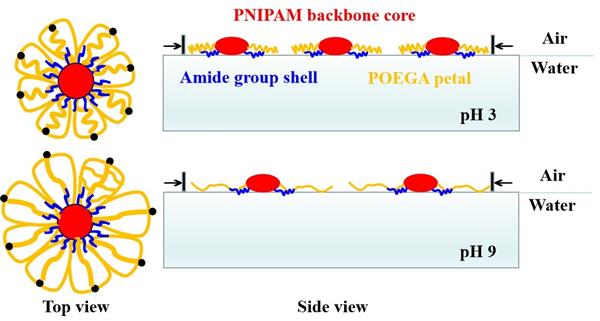作者:Pan, Wenting ; Chen, Hongxu ; Wen, Gangyao; Giaouzi, Despoina ; Pispas, Stergios; Zuo, Jintao
关键字:LB film; Double hydrophilic block copolymer; Surface micelle; Compression modulus
论文来源:期刊
具体来源:J. Phys. Chem. C 2020, 124(31), 17150–17157.
发表时间:2020年
Effects of subphase pH and temperature on the aggregation behavior of a thermosensitive double hydrophilic block copolymer (DHBC) of poly(N-isopropyl acrylamide)-block-poly[oligo(ethylene glycol) acrylate] (PNIPAM-b-POEGA) at the air/water interface and the morphologies of its Langmuir–Blodgett (LB) films were characterized with the Langmuir film balance technique and atomic force microscopy, respectively. The surface pressure-molecular area isotherm of each PNIPAM-b-POEGA monolayer exhibits the expanded type due to the contribution of the highly hydrophilic POEGA blocks, and finally shows a pseudoplateau attributed to their immersion into water. With the decrease of subphase pH, the compression isotherms shift negatively due to the gradually increased protonation degrees and underwater solubility of amide groups in PNIPAM blocks. The maximum compression modulus values of the monolayers are very low, indicating that the DHBC monolayers possess optimum compressibility. With the elevation of subphase temperature, the isotherms at different subphase pH first shift positively below the lower critical solution temperatures of PNIPAM and POEGA but then shift negatively above them. At low temperature, hysteresis degrees gradually decrease in the continuous compression-expansion cycles, whereas those at high temperature remain nearly unchanged. All initial LB films exhibit tiny circular micelles with core-shell-corona structures composed of PNIPAM backbone cores, amide group shells, and POEGA coronas, which is proposed in diblock copolymer systems for the first time. With the increase of subphase pH, the average core diameters decrease due to the increased deprotonation degrees of amide groups. With the elevation of temperature, furthermore, the neighboring micelle cores are easier to coalesce due to the increased molecular thermal mobility.

Article address: https://pubs.acs.org/doi/10.1021/acs.jpcc.0c05272.
Request link: https://pubs.acs.org/articlesonrequest/AOR-8ZPDG8YNCDKZ2KJGQ8J2.